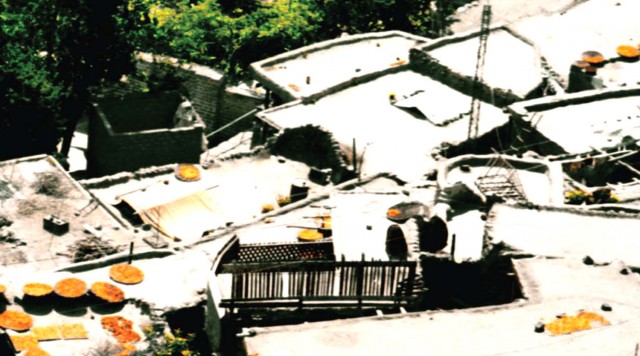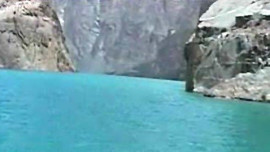
After hours of bone-rattling rides in an open jeep on often unpaved roads, to arrive in wildernesses, albeit of untouched beauty, Karimabad, the capital of Hunza presented a novel experience. The first thing I noticed were foreign backpackers trekking along the pathways interlinking shops and of all things… a café. And I don’t mean a dhabaa either but a glass-fronted, clean place with a sign outside in English advertising Hunza Muesli, honey and what was the clincher for me, coffee, sweet coffee. It is quite strange when you go into the heart of the North and find that instead of other Pakistanis experiencing what I can only call the magic, one finds instead the Germans and the Japanese. Many Pakistani mountain peaks sport German and Italian names.
The name of the café gave us much fodder for humour; Café De Hunza, was indeed all it was cracked up to be. I learnt to my great pleasure that all ingredients were locally sourced. Hunza Muesli is to die for as is Hunza honey. I can say with certainty, there is nowhere in the entire country, especially not in the rural areas where you will be offered fresh, homegrown muesli with milk and honey. This is a Hunza thing. I had not been privy to such healthy food choices in a while. This was mid-point in my journey and there were only ever three things on offer: daal, sabzi, murghi and I was going a little mad.
Which brings me to the apricots. Whilst driving into Hunza I noticed that kilometre after kilometre, blankets of orange adorned every rooftop of the clay houses terraced down the sides of inclines. After seeing nothing but apricot trees for miles I understood the orange rhapsody. Unaware of the Hunza-Apricot connection, I was enraptured by this abundance. So back to the café. They served fresh apricots with breakfast, apricot jam, and fresh apricot juice. For me it is a real joy in life to eat or drink something while standing on the very earth that it comes from. That first apricot juice in Hunza was like a spiritual experience.
Overlooking the village of Karimabad, atop a high rocky mountain is a structure that appears to be defying gravity. Large beams support the hexagonal shapes that make up the building. Wooden carvings adorn the peripheries. It calls to mind Chinese pagodas. This is the Baltit Fort. Built 600 years ago, it used to be the residence of the Mir of Hunza. It seemed the man was not very popular, and to this day the locals seemed to cringe when asked about either. I was told that the Mir was known to fling people off the rock face that the fort was perched on, and the way the man told the story it seemed as if the memory was lodged in his consciousness from yesterday and not centuries ago. The views that one is privy to in Karimabad are astonishing. Rakaposhi (7,788 meters) is the best known peak that you can really enjoy from a spot called Eagles Point, a short drive from the centre of Karimabad.
Looking down into the valley, one sees rich, lush, green fields terraced assiduously. The houses are also staggered this way, made of grey-coloured clay unlike other parts of the Northern areas where the clay is light yellow, or a deep red. One evening whilst out for a stroll in the perfectly cool air of July, I made a discovery. Tucked away was a board that had the words Hidden Paradise Restaurant in red painted on it. I scrambled about a bit and found the entrance up a small set of stairs. The space was cool and open, lit only by natural lighting. The furniture was all hewn of rough wood. “Come, come, please!” we were welcomed in by a man who seemed genuinely happy to see us. He sat us down and handed us menus. I was once again surprised. The menu was unlike anything I’d seen anywhere in Pakistan. Breads made of the meal of berries. The owner explained it all to us. I had seen these trees all over Hunza with little red fruits. These were dried and made into flour and used for the bread. Hunza-ites I learnt also made their own fresh white cheese. There was Apricot soup, and something called “Hunza Pizza,” or Chapshuro with what else but apricot oil drizzled over it. I ordered all of the above. The owner brought everything out shortly and as we tried each dish he waited and asked hopefully if we liked it. I told him it was all delicious and so fresh and unusual. Even the kernels of the apricot seed were used in breads and as topping for the soup. I found the ingenuity and independence of the dwellers of Hunza remarkable.
I was told Hunzaites used to live well into their hundreds, because this has been the type of fare, spice and oil free, they have always eaten. With urban migrations however, new culinary ideas infiltrated the previously holistic diet and so the desification of this unique culture started. According to Mr Hidden Paradise this has affected the legendary Hunza longevity. I find myself thinking of this little restaurant in Hunza often and hoping fervently it is still there.
Whilst standing at Eagles Point high above the valley, I had noticed what looked like a settlement made entirely of the signature grey clay. I learnt that this was Ganish, the oldest and first settlement on the ancient Silk Road in Hunza dating back 1,000 years, where people still dwell. Eager to visit this historical place, I took a winding ride down into the valley. A perfectly planned enclosed mini-city, Ganish is astonishing. It is testimony to the fact that humanity’s ancestors such as the Mayans and the Indus Valley, knew exactly what they were doing. Waterways are constructed throughout the village. I also noticed how clean they kept everything. We walked around the narrow pathways and were invited to enter every room, and every little shop. It was like being in a maze. Each home had a system for sewage removal, using running water. The grey clay walls and floors keep everything cool like the adobe homes found in the South-West of America. In the centre of the settlement is a large communal water reservoir. I have never seen anything like this in Pakistan that is still standing with its original integrity intact. There are still families living in the ancient settlement of Ganish, which won a Unesco award just this year for its cultural heritage, who are the descendants of the original settlers.
I had also noticed besides the Baltit Fort, an imposing structure high up in the hills; a very grand-looking hotel apparently owned by the current Mir and his family. It seemed rather out-of-place what with the rustic albeit sinister beauty of the Baltit Fort, the mystique of Hidden Paradise and the ancient aura of Ganish, but on my last night I thought to try to get a bite to eat up there, being rather fed up of all things apricot by that time. It was a pleasant walk up the hill but as I got closer I was struck by how desolate and dark it looked. I walked into a massive entrance hall with elaborate but gaudy decoration expecting to hear the tinkling of cutlery, some laughter coming from somewhere, the murmur of conversation… or heaven forbid a concierge of some kind, but nothing emanated. My companion and I looked at each other askance. The atmosphere was foreboding, like the set of an old horror movie. Wandering about into empty space after empty space, finally walking out onto a large terrace we found to our surprise a few men dressed as waiters and a barbeque with a fire blazing in it. They seemed just as surprised to see us. In fact, when we told them we had come to eat they seemed to want to dissuade us from this objective, but by that time we were famished and insisted that they show us a menu. There wasn’t much on there. The fantastic local cuisine was nowhere to be seen. All we could see on offer were chicken tikkas for the rather ridiculous sum of 300 rupees each. I kept looking around for signs of life and wondering why the place was open at all.
I often think of that strange dinner, chomping on an exorbitant tikka, in that abandoned hotel overlooking the twinkly lights of the Hunza valley. What a disparity there was between the rulers and the ruled’s visions of Hunza.
Published in the Express Tribune, June 13th, 2010.





























































COMMENTS
Comments are moderated and generally will be posted if they are on-topic and not abusive.
For more information, please see our Comments FAQ